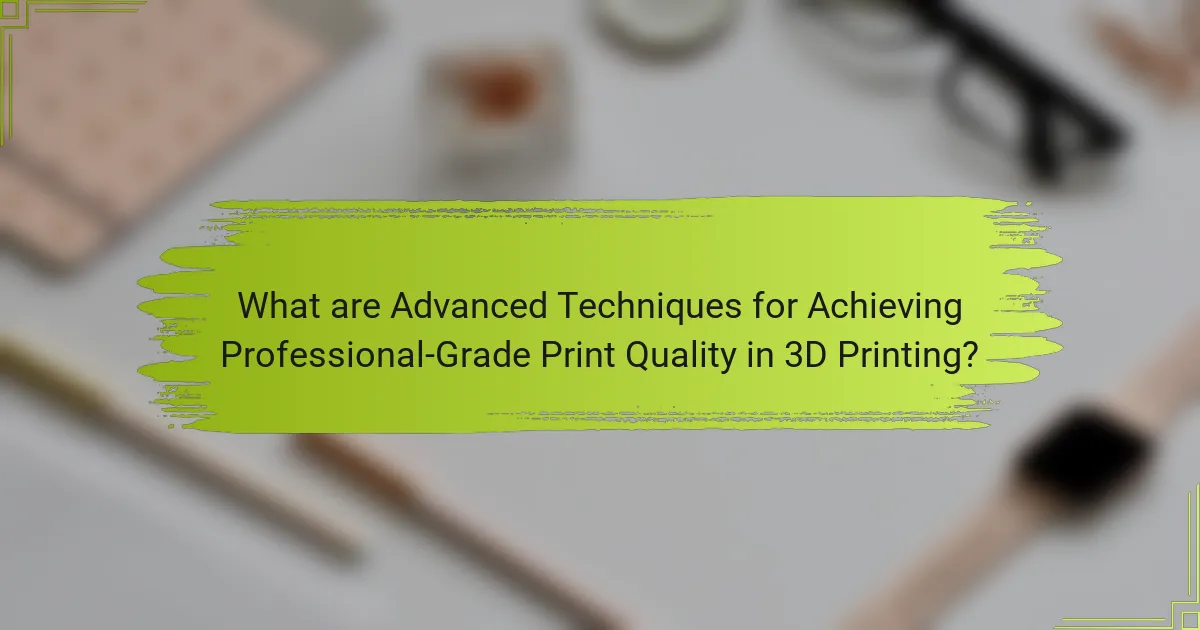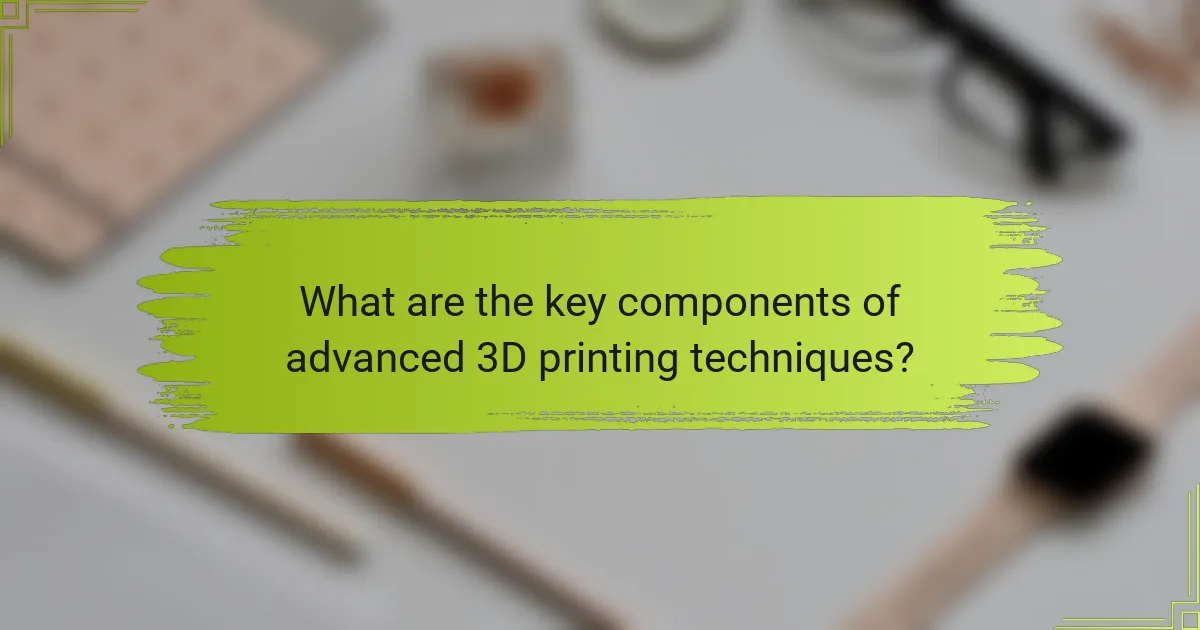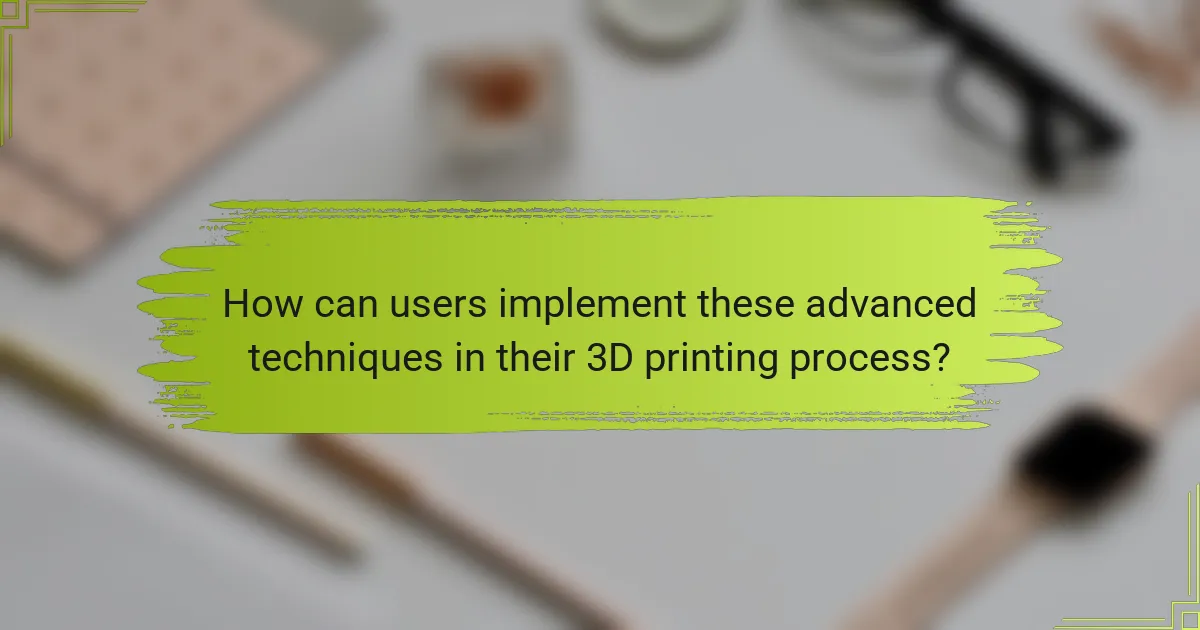
What are Advanced Techniques for Achieving Professional-Grade Print Quality in 3D Printing?
Advanced techniques for achieving professional-grade print quality in 3D printing include optimizing print settings, using high-quality materials, and employing post-processing methods. Adjusting parameters such as layer height, print speed, and temperature can significantly enhance print quality. Selecting premium filaments with consistent diameter and minimal impurities ensures better adhesion and surface finish. Implementing advanced slicing software can improve support structures and infill patterns, contributing to overall strength and appearance. Post-processing techniques like sanding, painting, or vapor smoothing refine the final product’s aesthetics. Utilizing dual extrusion printers allows for multi-material prints, enhancing functionality and visual appeal. Regular maintenance of the printer, including nozzle cleaning and bed leveling, is crucial for consistent results. These methods collectively lead to higher precision and a professional finish in 3D printed objects.
How do these techniques enhance print quality?
Advanced techniques enhance print quality by improving layer adhesion, reducing defects, and optimizing material usage. Techniques such as precise temperature control ensure consistent melting and extrusion of materials. This leads to better layer bonding and overall strength of the print.
Additionally, advanced slicer settings allow for fine-tuning of print speed and layer height. This results in smoother surfaces and more detailed features. Techniques like multi-material printing enable the use of different materials for specific properties, enhancing functionality.
Research indicates that optimized print parameters can increase dimensional accuracy by up to 30%. This is crucial for applications requiring high precision. Overall, these techniques significantly elevate the final output quality in 3D printing.
What specific aspects of print quality are improved by these techniques?
The specific aspects of print quality improved by advanced techniques in 3D printing include surface finish, dimensional accuracy, and layer adhesion. Surface finish is enhanced through methods like post-processing, which smooths out imperfections. Dimensional accuracy is improved by precise calibration and advanced slicing algorithms, ensuring that the final print matches the intended design closely. Layer adhesion benefits from optimized extrusion temperatures and speeds, resulting in stronger bonds between layers. These improvements lead to higher-quality prints that are more aesthetically pleasing and structurally sound.
How do advanced techniques compare to standard methods?
Advanced techniques in 3D printing offer superior outcomes compared to standard methods. These techniques enhance precision, resulting in finer details and smoother finishes. Advanced methods often utilize sophisticated algorithms and improved materials. This results in reduced print times and minimized material waste. For instance, techniques like multi-material printing enable complex geometries that standard methods cannot achieve. Additionally, advanced techniques often incorporate real-time monitoring for quality assurance. This leads to higher success rates in print jobs. Overall, advanced techniques significantly elevate the quality and efficiency of 3D printing compared to standard practices.
Why is achieving professional-grade print quality important?
Achieving professional-grade print quality is important for ensuring high fidelity and accuracy in 3D printed objects. High-quality prints enhance the visual appeal and functional performance of the final product. They meet industry standards and customer expectations, which is crucial for businesses. Professional-grade quality reduces the need for post-processing and minimizes material waste. According to a study by the Additive Manufacturing Research Group, higher print quality can improve the mechanical properties of 3D printed parts. This leads to increased durability and reliability in applications such as aerospace and automotive industries. Overall, professional-grade print quality directly impacts customer satisfaction and market competitiveness.
What impact does print quality have on end-user satisfaction?
Print quality significantly impacts end-user satisfaction. High print quality leads to better visual appeal and functionality of 3D printed objects. Users often associate high-quality prints with professionalism and reliability. A survey by the 3D Printing Industry found that 75% of users prioritize print quality in their purchasing decisions. Poor print quality can result in defects, which frustrate users and diminish their overall experience. Consistent quality assurance in printing processes enhances user trust and loyalty. Ultimately, superior print quality is a key factor in achieving high levels of end-user satisfaction.
How does print quality influence industry standards?
Print quality significantly influences industry standards by setting benchmarks for performance and customer satisfaction. High print quality ensures that products meet specific durability, accuracy, and aesthetic requirements. For example, in 3D printing, precise layer resolution and material consistency are critical for functional prototypes. Industry leaders often establish guidelines based on optimal print quality metrics. These guidelines help manufacturers align their processes with customer expectations. Consequently, companies that prioritize print quality can gain a competitive edge. Research indicates that improved print quality reduces waste and production costs, further reinforcing its importance in industry standards.

What are the key components of advanced 3D printing techniques?
The key components of advanced 3D printing techniques include precision hardware, advanced materials, and sophisticated software. Precision hardware ensures accurate layer deposition and alignment. High-resolution printers often utilize laser or multi-jet fusion technologies. Advanced materials provide enhanced properties like strength, flexibility, and heat resistance. Common materials include thermoplastics, metals, and composites. Sophisticated software enables complex design and simulation capabilities. Software tools often include slicing algorithms and real-time monitoring systems. These components work together to enhance print quality and efficiency.
What types of 3D printers are best suited for professional-grade results?
Fused Deposition Modeling (FDM), Stereolithography (SLA), and Selective Laser Sintering (SLS) are the best types of 3D printers for professional-grade results. FDM printers are widely used for their versatility and cost-effectiveness. They extrude thermoplastic filament layer by layer to create durable parts. SLA printers utilize a UV light source to cure resin into solid objects, achieving high-resolution prints. SLS printers use a laser to fuse powdered material, allowing for complex geometries and strong parts. Each type offers unique benefits based on the application, such as speed, material variety, and detail.
What features should one look for in a high-quality 3D printer?
A high-quality 3D printer should have features such as high resolution, reliable build quality, and versatile material compatibility. High resolution allows for detailed prints, typically measured in microns. Reliable build quality ensures durability and consistent performance over time. Versatile material compatibility enables the use of various filaments like PLA, ABS, and PETG.
Additionally, a heated bed improves adhesion and reduces warping, while an enclosed build chamber helps maintain temperature stability. A user-friendly interface, such as a touchscreen, enhances ease of operation. Connectivity options like Wi-Fi and USB support flexible printing methods. Finally, a strong community and customer support can provide valuable resources and troubleshooting assistance.
How do printer specifications affect print outcomes?
Printer specifications significantly influence print outcomes. Key specifications include resolution, print speed, and nozzle diameter. Higher resolution results in finer details and smoother finishes. Print speed affects the time taken to complete a job, impacting layer adhesion and overall quality. Nozzle diameter determines the thickness of extruded filament, influencing detail and strength. For example, a 0.4 mm nozzle produces more detail than a 1.0 mm nozzle but takes longer to print. Additionally, the type of filament used, temperature settings, and layer height are crucial. Research indicates that optimal settings lead to superior print quality.
What materials contribute to achieving superior print quality?
High-quality materials significantly enhance print quality in 3D printing. These include PLA, ABS, PETG, and Nylon. PLA offers excellent surface finish and detail retention. ABS provides durability and strength but can warp. PETG combines ease of use with flexibility and strength. Nylon is known for its toughness and impact resistance. Each material’s properties directly influence the final print’s appearance and functionality. For example, studies show that PLA prints exhibit smoother finishes compared to ABS and PETG. Additionally, the choice of filament can affect layer adhesion and overall structural integrity.
What are the advantages of using specific filament types?
Specific filament types offer distinct advantages in 3D printing. PLA filament is user-friendly and biodegradable, making it ideal for beginners and environmentally conscious projects. ABS filament provides high durability and heat resistance, suitable for functional parts. PETG filament combines the best of both worlds, offering strength and flexibility. TPU filament is known for its elasticity, perfect for creating flexible components. Each filament type contributes unique properties that enhance print quality and application suitability. For instance, PLA’s ease of use results in fewer print failures, while ABS’s robustness allows for parts that withstand higher temperatures.
How do material properties affect the final print quality?
Material properties significantly influence final print quality in 3D printing. The choice of filament affects adhesion, strength, and finish. For example, PLA has good adhesion and a smooth finish, while ABS offers higher strength and durability. Different materials also respond differently to temperature and humidity, impacting layer bonding and warping. High-quality materials can reduce defects such as stringing and under-extrusion. Moreover, the viscosity of the material affects flow rate and layer resolution. Research indicates that the right material selection can enhance dimensional accuracy and surface detail. Therefore, understanding material properties is crucial for achieving professional-grade print quality.

How can users implement these advanced techniques in their 3D printing process?
Users can implement advanced techniques in their 3D printing process by optimizing printer settings and materials. Adjusting layer height can improve surface finish and detail. Using high-quality filaments enhances durability and print quality. Calibration of the printer ensures accurate dimensions and alignment. Incorporating supports and rafts can prevent warping and improve adhesion. Utilizing advanced slicing software allows for better control over print parameters. Experimenting with print speed and temperature can yield different results. Regular maintenance of the printer prolongs its life and performance. These practices lead to professional-grade print quality.
What are the best practices for optimizing print settings?
To optimize print settings for professional-grade 3D printing, focus on precision and material compatibility. Adjust layer height for desired detail; lower heights yield finer details. Set print speed to balance quality and time; slower speeds enhance accuracy. Calibrate temperature settings based on material specifications; optimal temperatures improve adhesion and reduce warping. Use appropriate infill density to ensure strength without excessive material use; typically, 20-30% infill suffices for most prints. Select the right nozzle size for the project; larger nozzles increase speed, while smaller ones enhance detail. Regularly maintain and clean the printer to prevent issues; this includes checking for clogs and ensuring proper alignment. Lastly, use slicer software effectively to preview and adjust settings before printing; this helps identify potential issues early.
How can layer height and print speed be adjusted for better results?
To achieve better results in 3D printing, layer height and print speed can be adjusted strategically. Lowering the layer height increases print resolution and detail. This results in smoother surfaces and more intricate designs. However, it also increases print time. Conversely, increasing the layer height decreases print time but may sacrifice detail.
Adjusting print speed also impacts print quality. Slower print speeds enhance adhesion between layers, reducing the risk of defects. Faster speeds can lead to issues like stringing or poor layer bonding. It is essential to find a balance between speed and quality for optimal results.
For example, a layer height of 0.1 mm paired with a print speed of 40 mm/s often yields high-quality prints. In contrast, a layer height of 0.3 mm at 60 mm/s may produce faster prints but with less detail. Testing different combinations can help determine the best settings for specific projects.
What role does temperature play in achieving professional-grade prints?
Temperature is crucial in achieving professional-grade prints. It affects the melting point of the material being used. For example, PLA typically prints well at 180-220°C. If the temperature is too low, the filament may not extrude properly. Conversely, if the temperature is too high, it can lead to issues like stringing or oozing. Consistent temperature helps maintain layer adhesion. This results in stronger and more durable prints. Research indicates that optimal temperature settings can reduce warping and improve surface finish. Thus, controlling temperature is essential for high-quality 3D printing outcomes.
What troubleshooting tips can help improve print quality?
To improve print quality in 3D printing, ensure proper bed leveling. A well-leveled bed prevents layer adhesion issues. Check the nozzle temperature; incorrect temperatures can lead to poor extrusion. Use the recommended filament settings for optimal results. Clean the nozzle regularly to avoid clogs that affect flow. Ensure the filament is dry, as moisture can cause bubbles and imperfections. Adjust print speed; slower speeds can enhance detail and layer bonding. Lastly, use high-quality filaments to achieve better overall print quality.
How can users identify common print quality issues?
Users can identify common print quality issues by examining specific visual and structural characteristics of the printed object. Key indicators include layer misalignment, which appears as uneven surfaces or gaps between layers. Another sign is stringing, where fine threads of filament connect different parts of the print. Users should also look for under-extrusion, characterized by gaps or weak areas in the print. Over-extrusion can be identified by excess filament causing blobs or a rough surface texture. Warping occurs when the edges of the print lift, indicating poor adhesion to the print bed. Users can also check for color inconsistencies, which may signal issues with filament quality or printer settings. Observing these characteristics allows users to diagnose and address print quality problems effectively.
What solutions can be applied to enhance print quality effectively?
To enhance print quality effectively in 3D printing, several solutions can be implemented. First, using high-quality filament improves the overall print outcome. Filaments with consistent diameter and composition lead to better layer adhesion. Second, optimizing print settings is crucial. Adjusting temperature, speed, and layer height can significantly affect the final quality. Third, ensuring proper bed leveling prevents first-layer issues, which are critical for successful prints. Fourth, maintaining a clean print nozzle reduces clogs and inconsistencies during printing. Additionally, utilizing a well-calibrated printer ensures accurate dimensions and surface finishes. Finally, post-processing techniques, such as sanding or painting, can enhance the appearance of the printed object. These methods collectively contribute to achieving professional-grade print quality.
Advanced techniques for achieving professional-grade print quality in 3D printing focus on optimizing print settings, selecting high-quality materials, and employing effective post-processing methods. Key improvements include enhanced layer adhesion, dimensional accuracy, and surface finish, which are critical for meeting industry standards and customer expectations. The article also explores the impact of specific printer types, material properties, and best practices for optimizing print outcomes, providing actionable insights for users seeking to elevate their 3D printing capabilities. Additionally, troubleshooting tips and solutions for common print quality issues are discussed to further aid in achieving superior results.